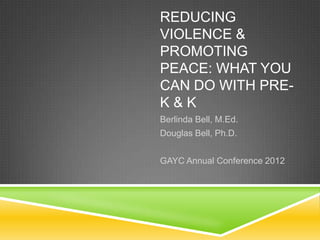
Reducing violence and promoting peace prek and k
- 1. REDUCING VIOLENCE & PROMOTING PEACE: WHAT YOU CAN DO WITH PRE- K&K Berlinda Bell, M.Ed. Douglas Bell, Ph.D. GAYC Annual Conference 2012
- 2. THE PROBLEM Children are exposed to an incredible amount of violence The brain of children develops differently from prolonged and extreme exposure to violence Children do not know how to social problem solve Children have difficulty with seeing things from another’s point of view
- 3. THE SOLUTION TEACH THEM! We have a big disconnect in early childhood classrooms. We focus on activities and don’t make and atmosphere of safety. Prevention is the key
- 4. SOCIAL SKILLS THAT BUILD RESILIENCE Empathy Identification of emotions Expression of emotions Waiting/patience Sharing/turn taking Conflict resolution (social problem solving) Others?
- 5. HOW DO WE TEACH THEM We must create and atmosphere of peace and caring, we must promote problem solving Adjust the environment Adjust the program Adjust and include purposeful activities Adjust our own attitude Adjust our interactions
- 6. ADJUST THE ENVIRONMENT Include softness Remove materials that lend themselves to violence Use furnishings that tell the children they belong Have a place for calming self down Have a place for sensory play Have a place for social problem solving (conflict resolution) Have sufficient amount of materials
- 7. ADJUST THE PROGRAM Keep a balanced schedule Be sensitive to the need to move Be sensitive to the need to breath and have brain breaks Be sensitive to sensory input Maximize routines as opportunities to connect and discuss social issues Have caring routings (wish well, helpers, I care notes) Use dramatic play Provide intensity and density of the 3 types of play
- 8. ADJUST AND INCLUDE PURPOSEFUL ACTIVITIES Discourage violent themed play but respect the children’s needs for some of it (to overcome fears) Encourage cooperative activities Do connecting activities both with individual children and the group daily Have children do connecting activities with each other daily Role play social problem solving Read social stories (at least one with each theme) Teach breathing and self calming
- 9. INTEGRATE OPPORTUNITIES Embed social skills in all activity areas when ever possible Reading Writing Math Dramatic play Blocks Science Social studies
- 10. I LOVE YOU RITUALS Have eye contact Have touch Have presence Have a playful exchange
- 12. CONFLICT RESOLUTION Did you like it? Did you tell them? I don’t like it when ____, Next time will you ____. I can do that Identify problem Propose solutions Try one Evaluate
- 13. ADJUST YOUR OWN ATTITUDES You have to care, especially about the tough ones Really see the children Promote a Yes you can attitude See conflicts as a teaching opportunity See the best in each child Recognize the lack of knowledge rather than seeing them as bad Be willing to increase their toolbox
- 14. ADJUST YOUR INTERACTIONS Address all acts of violence and all types Model don’t just tell Have children notice the face of others Keep your own calm Respond rather than react “you’re a problem solver” Share your calm Celebrate the small successes “you did it, you ___” Use belonging language Keep a we attitude not a big against small one
- 15. POSITIVE WAYS TO GET ATTENTION Clapping activity Chants Bell Others ? Be sure to provide individual connections each day
- 16. RESOURCES Growing Sound CD’s Red Grammer, Teaching Peace & Be Bop Your Best cds Kindness Counts cd by Mr Al It Starts in the Heart cd by Jack Hartman The kindness curriculum Early Violence Prevention: Tools for Empowering Teachers by NAEYC Violence in the Lives of Children by NAEYC The Antibullying Book by Gryphon House The cooperation booklet by Totline The Peaceful Classroom Conscious Discipline by Becky Bailey